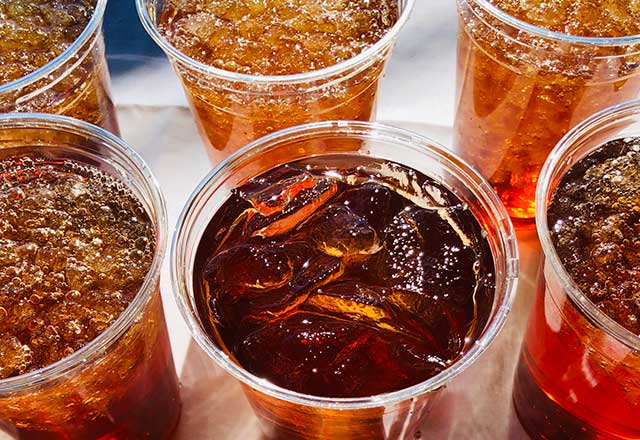Coke, Pepsi, Dr. Pepper, Sprite, Sunkist, Mountain Dew, Sunny D, Brisk, Fanta, Kuat, Capri Sun and others — what do these drinks have in common? They’re all sugar-sweetened beverages.
Sugar-sweetened beverages, or sugary drinks, are composed of any liquid sweetened with one or more forms of sugars, and they are the main source of added sugars in the American diet. Examples of added sugars include brown sugar, corn sweetener, corn syrup, dextrose, fructose, glucose, high-fructose corn syrup (HFCS), maltose, honey, lactose, malt syrup, molasses, raw sugar and sucrose. Out of these sugars, sucrose and high-fructose corn syrup (which consists of glucose and fructose in a 45:55 ratio) are the primary sweeteners of food and sugary beverages.
Since the 1980s, increased consumption of sugary drinks has been paralleled by a global obesity epidemic. Another incidence of disease that has increased during this time is the rate of colorectal cancer among young and middle-aged adults, hinting at a connection between sugary drinks, obesity and colorectal cancer development. However, the direct contribution of sugar-sweetened beverages to the formation of tumors (tumorigenesis) is unclear.
High Fructose Corn Syrup Consumption Promotes Intestinal Tumor Growth
In a recent study published in Science, researchers investigated whether and how beverages sweetened with high-fructose corn syrup can directly feed cancers and boost their growth. To do this, the researchers used a genetically engineered mouse model of intestinal tumorigenesis. Researchers knocked out a gene called “adenomatous polypsis coli,” APC for short, which normally suppresses tumor formation. Because APC knockout (APC KO) mice lack this gene, they develop intestinal tumors.
APC KO mice and control mice were allowed to drink water with 25 percent high-fructose corn syrup at their leisure over an eight-week period, which resulted in both groups developing obesity. Moreover, control mice developed metabolic syndrome — a group of conditions that, together, increases your risk of heart disease, stroke and type 2 diabetes. In order to study the effects of HFCS outside obesity, investigators fed APC KO mice a daily oral amount of HFCS equivalent to human consumption of 12 ounces or less of sugar-sweetened beverages per day. The mice were no longer drinking HFCS-rich water at their leisure, but fed a restricted amount (see Table 1 below).
Table 1. Summary of HFCS treatment for eight weeks.
| Mouse Dose | Human Caloric Equivalency |
| 400 µl of 25% HFCS in water
(3% of total daily caloric intake) |
12 ounces of sugar-sweetened beverage per day (approximately 20 grams of HFCS) |
This chronic HFCS regimen did not result in obesity or metabolic syndrome in tumor-bearing mice, and APC KO mice treated with HFCS developed a total number of tumors that was similar to the APC KO mice that were not treated with HFCS. However, the tumors in the HFCS-fed mice were bigger and considered more dangerous than those that developed in the mice that were not fed HFCS. These results suggest that long-lasting daily consumption of HFCS in liquid form facilitates tumor growth in the setting of APC deficiency regardless of obesity and metabolic syndrome manifestation.
Tumors Use Fructose and Glucose to Their Own Metabolic Ends
Why would sugar consumption of HFCS cause tumor growth? Researchers think that the tumors have found a way to absorb both fructose and glucose and use them as energy for their own growth. They discovered that fructose from HFCS was consumed first, and ATP — a molecule used as energy “currency” in the cell — was rapidly lowered in tumor-bearing mice. This decrease in ATP then accelerated glucose breakdown and metabolic routes for turning glucose into fat. However, the amount of fructose that reached the bloodstream was reduced in the tumor-bearing mice when compared with mice without tumors, suggesting that fructose is “stuck” around the tumors instead of reaching the bloodstream and liver.
But wait, how are the tumors growing if they have less energy? Basically, the primary effect of fructose combined with lower ATP levels that arise from consuming HFCS is tricking the tumor cells into thinking they don’t have a lot of energy, so they kick-start the breakdown of glucose to use for their growth.
Overall, these results identify HFCS, even at a moderate dose, as a main contributor to tumor formation and growth in mice by stimulating glucose breakdown. These surprising results demonstrate a direct molecular mechanism for the correlation between sugary drink consumption and colorectal cancer.
Since fructose is not essential for the survival and growth of normal cells, inhibitors of the pathways used to transport it into the intestines or breakdown of this sugar might impede the growth of colorectal cancer cells. Therapeutic targeting of fructose metabolism and further studies in humans are needed to explore novel strategies for slowing the progression of colorectal cancer.
Hopefully, these findings will also help raise public awareness regarding the potential harmful consequences of common sugary drinks on human health, and impact the field of colorectal cancer by suggesting new ways to slow down or stop growth of the disease.
